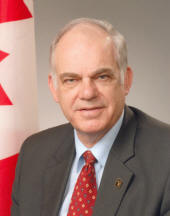Common menu bar links
Breadcrumb Trail
ARCHIVED - Canadian Radio-television and Telecommunications Commission
 This page has been archived.
This page has been archived.
Archived Content
Information identified as archived on the Web is for reference, research or recordkeeping purposes. It has not been altered or updated after the date of archiving. Web pages that are archived on the Web are not subject to the Government of Canada Web Standards. As per the Communications Policy of the Government of Canada, you can request alternate formats on the "Contact Us" page.
SECTION I: Overview

As Minister of Canadian Heritage and Official Languages, I am pleased to present the Canadian Radio-television and Telecommunications Commission's (CRTC) Departmental Performance Report for 2007-2008. The report outlines the important achievements of the CRTC over the last fiscal year and demonstrates how it continues to fulfill its mandate.
As the activities highlighted in the report show, the CRTC is at the forefront of the international community of communications regulators. With its mandate to oversee broadcasting and telecommunications, it is well positioned to deal with the technological developments that have brought these industries even closer together over the past year. Canadians were able to enjoy a growing number of broadcasting services in both official languages and in other languages as well. Many of these services featured the talents of Canadian creators. In addition, nearly every Canadian home has access to advanced telecommunications services, including wireless and high-speed Internet services.
As a Canadian Heritage agency, the CRTC has helped create a more prosperous Canada in which Canadians of all generations and all backgrounds can take part in the rich social, cultural and economic life this country has to offer.
The Honourable James Moore, P.C., M.P.
Chairman's Message
 I am pleased to present the Canadian Radio-television and Telecommunications Commission's (CRTC's) Departmental Performance Report for 2007-2008. This report highlights what has not only been an exceptionally busy year at the CRTC, but also the first of my term as
Chairman.
I am pleased to present the Canadian Radio-television and Telecommunications Commission's (CRTC's) Departmental Performance Report for 2007-2008. This report highlights what has not only been an exceptionally busy year at the CRTC, but also the first of my term as
Chairman.
The CRTC pursued four priorities last year. First, the CRTC emphasized the promotion and protection of Canadian culture. This directive was focused in our minds as we reviewed the CRTC's policies for conventional television broadcasters. These broadcasters make significant contributions to Canadian culture through the production, acquisition and broadcast of high-quality Canadian programming. In May 2007, we introduced measures that will enable them to continue fulfilling this important role within a rapidly changing environment.
Second, the CRTC reviewed five major transactions involving some of the country's largest media companies. We established new benchmarks by issuing these decisions in a timely fashion and, in some instances, imposed stringent conditions to ensure that control of Canada's media companies remained in Canada. At the same time, the CRTC developed new rules to preserve the diversity of voices in the Canadian broadcasting system, particularly in today's era of convergence.
Third, the CRTC continued to implement the government's policy direction to rely on market forces as much as possible under the Telecommunications Act. Healthy competition between cable and telecommunications companies has allowed the CRTC to lift its regulation of local telephone service in communities across the country.
Finally, we deregulated, as of 2012, 121 wholesale telecommunications services, which are provided by established companies to their competitors.
I have highlighted some of the many activities undertaken by the CRTC over the past year. These achievements, and others outlined in this report, demonstrate our commitment to developing a modern regulatory framework that contributes to Canada's social, cultural and economic prosperity. I look forward to working closely with the CRTC's dedicated staff and Commissioners to meet the challenges that await us in the year ahead.
Konrad von Finckenstein, Q.C.
Management Representation Statement
I submit, for tabling in Parliament, the 2007-2008 Departmental Performance Report (DPR) for the Canadian Radio-television and Telecommunications Commission (CRTC).
This document has been prepared based on the reporting principles contained in the Guide for the preparation of Part III of the 2006-2007 Estimates: Reports on Plans and Priorities and Departmental Performance Reports:
- It adheres to the specific reporting requirements outlined in the Treasury Board Secretariat guidance;
- It is based on the department's strategic outcomes and Program Activity Architecture that were approved by the Treasury Board;
- It presents consistent, comprehensive, balanced and reliable information;
- It provides a basis of accountability for the results achieved with the resources and authorities entrusted to it; and
- It reports finances based on approved numbers from the Estimates and the Public Accounts of Canada.
___________________________________
Robert A. Morin, Secretary General
Raison d'�tre
The CRTC's challenge is to serve the public interest by maintaining a balance among the cultural, social and economic goals of the legislation on broadcasting and telecommunications, taking into account the wants and needs of Canadians.
Like most organizations, the CRTC does not work in isolation. Environmental factors over which it has little or no control, such as the state of the economy, capital markets, societal change and emerging technology, influence the CRTC's work, priorities and outcomes.
Four principles will govern the Commission's management of the regulatory process in the coming years:
- transparency
- fairness
- predictability, and
- timeliness.
Transparency means that the Commission will be as open as possible in its dealings with all the stakeholders, as far as the law permits. Everyone should see exactly what we are doing, and why, so that they understand how we function and how they can interact with us.
Fairness means that every matter that comes before us shall be handled with well-established, even-handed procedures that will lead us to a well-considered outcome.
Predictability means that when we make decisions, we will follow a clear direction and will be consistent. And if we depart from our direction, we have to explain why, and specify whether this departure is an exception or a change in course.
Timeliness is a concept that means we should make our decisions as quickly as we can in a responsible manner.
Broadcasting Environment
Canada's broadcasting system is one of the most open and advanced in the world, both technologically and in terms of programming variety. Canadians enjoy a vast array of radio and television services that offer a wide range of international and domestic programs. The broadcasting system has also benefited from the contributions of private, public and community broadcasters, each of whom has played a distinct and important role in its evolution.
More than just open and advanced, Canada's state-of-the-art broadcasting system also:
- gives Canadians access to hundreds of broadcasting services regardless of where they live in Canada
- offers an increasing array of niche programming, as a result of unprecedented growth in specialty television services
- is poised to fully adopt digital broadcasting technology
- delivers broadcasting services throughout the country in both official languages
- makes important cultural and economic contributions to Canada, and
- has grown into a multi-billion dollar industry that employs a wide variety of people, from artists, writers and actors to technicians and engineers.
The above successes notwithstanding, the Commission fully recognizes that the broadcasting system faces significant challenges. Technological evolution, for example, has all but erased traditional broadcasting boundaries. As a result, broadcasters must now amend their business plans to continue to provide increased access to a wide variety of services from around the world, while also fostering a financially viable and culturally important Canadian broadcasting system. In this context, the Commission is working diligently to increase the number of Canadian programming services, as well as the availability of foreign-language services, to better serve the diversity of the Canadian population.
One of the most important aspects of the Commission's work is fulfilling the social and cultural objectives of the Broadcasting Act. The Commission must continue to regulate the broadcasting sector, to ensure the availability of quality Canadian programs and the accessibility of programming for all Canadians. Nevertheless, this regulation should be smarter and more efficient in order not to create obstacles to the broadcasting sector's economical development.
The Commission will continue to work collaboratively with the broadcasting industry to ensure that the business and cultural challenges ahead are successfully met.
Telecommunications Environment
Telecommunications is an important component of the social and economic fabric of Canada. It is universally available: more than 98% of Canadian households subscribe to landline or mobile phone service.
The Canadian telecommunications industry continued to grow in 2007, on the strength of increased demand for mobile-phone and Internet services. Competitors of the traditional telephone companies increased their share of total telecommunications revenues, including land-line and mobile-phone service revenues, to 41% in 2007.
Other characteristics of Canada's telecommunications environment include:
- some of the lowest-priced long-distance services in the world
- a healthy and competitive mobile-phone services market that experienced an 8% increase in subscribers and a 14% increase in revenues in 2007
- a competitive high-speed Internet services market that continues to grow (more than 94% of Canadian households can subscribe to broadband service and, in 2007, 69% did), and
- growth in local competition among telephone-service providers that saw cable companies and other non-traditional telephone-service providers capture 18% of local residential lines by the end of 2007.
In December 2006, the Governor-in-Council issued a policy direction to the CRTC that directed the Commission to rely on market forces to the maximum extent feasible as the means of achieving the policy objectives set out in the Telecommunications Act. At that time, the Commission estimated that 30% of telecommunications revenues were subject to economic regulation.
By March 31, 2008, approximately 71% of residential lines and 64% of business lines were free from economic regulation. Overall, approximately 90% of total telecommunications revenues come from unregulated services.
Policy Development and Research
In early 2007, the CRTC completed a reorganization to enable it to respond to the telecommunications and broadcasting industries' rapidly evolving technological, cultural, socio-economic and convergent landscapes. Under the new structure, the Policy Development and Research (PDR) sector is responsible for reviewing major ownership transactions, as well as the development of regulatory policy for conventional and new distribution platforms, including new media.
As noted above, the broadcasting industry, despite its current health, faces substantial challenges. These include the challenge of technological evolution, which has resulted in a truly global environment for television and for radio. New technologies have created new media. The emergence of new media, or the provision of audiovisual services delivered and accessed over the Internet or other non-traditional networks, has created a number of new challenges for the CRTC.
With respect to telecommunications, traditionally there have been two separate and independent landline networks in Canada that accessed Canadian homes; the local telephone network and the cable distribution network. The major cable companies have evolved their networks to deliver not only advanced cable services but telecommunications services as well, such as Internet access service and more recently local telephone service.
The PDR sector's responsibility is to provide strategic advice to the CRTC in an environment in which players in the telecommunications and broadcasting industries are at once converging within corporate and technological structures and fragmenting as audiences and customers take advantage of quickly multiplying choice.
